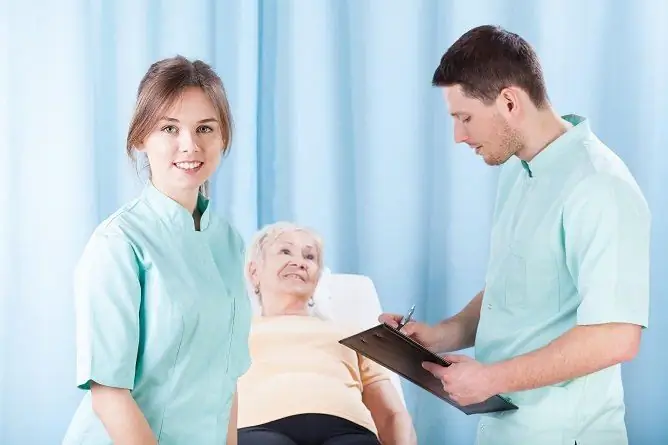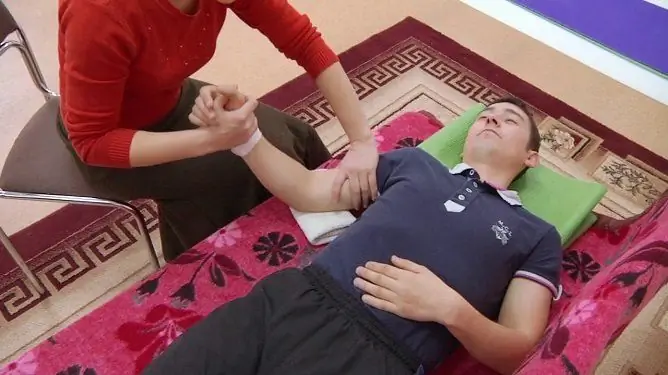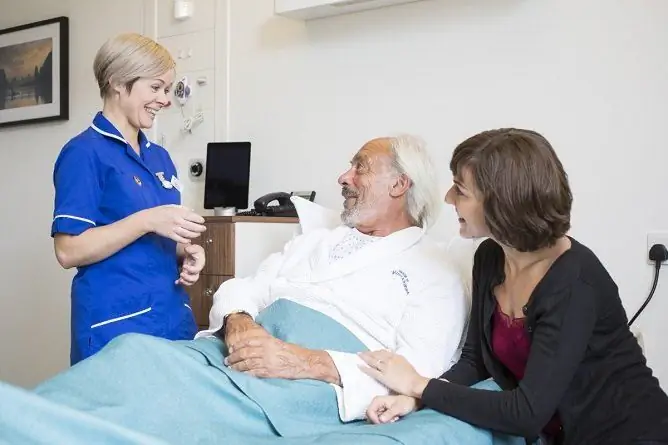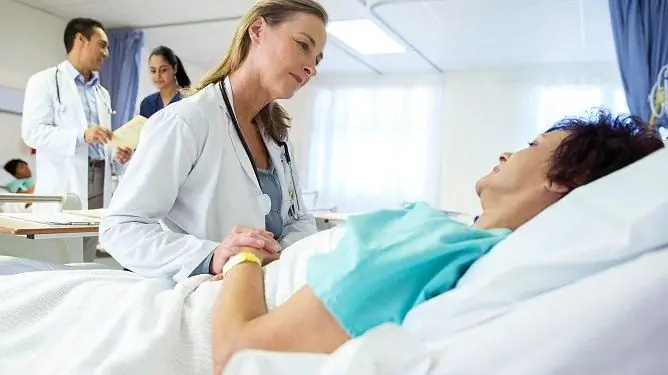- Author Rachel Wainwright [email protected].
- Public 2023-12-15 07:39.
- Last modified 2025-11-02 20:14.
Stroke patient care: caring for a bedridden patient at home and in a hospital
The content of the article:
-
How to care for a patient after a stroke at home
- Prevention of bedsores
- Correct limb position
- Exercise is an important part of stroke care
- Prevention of post-stroke complications
- Hygiene in stroke patients
- Organization of meals for the patient after a stroke
- Post-stroke rehabilitation in a hospital
- Video
Caring for patients after a stroke is the key to improving the quality of their life and a speedy recovery. A stroke patient requires constant care. The simplest manipulations become a problem for him - personal hygiene, food consumption, movements are not easy. This short guide will help you get comfortable with patient care.

Quality care after a stroke contributes to the early rehabilitation of the patient
How to care for a patient after a stroke at home
The patient's stay in the hospital is mandatory in the first days after the stroke, where he is looked after by medical personnel. After stabilization, the patient can be discharged home, but the treatment continues. Caring for such a patient should be approached extremely responsibly - you need to be near him most of the day, support all the functions of his body, carry out hygienic care and provide all possible psychological support.
The patient spends most of the time in bed, in a supine position. Staticity is fraught with the appearance of pressure ulcers, muscle atrophy (special exercises are carried out to maintain them in good shape) and dysfunction of the joints.
Prevention of bedsores
Pressure ulcers are a major problem in patient care. They are caused by impaired blood circulation in the superficial tissues, they are treated for a long time, as they do not respond well to therapy. To prevent bedsores, every one and a half to two hours a person needs to be turned over, the position of the body should be changed, and special air mattresses or vibro-mattresses should be used to prevent their appearance.
Correct limb position
After a hemorrhagic or ischemic stroke, the patient may be paralyzed, either completely or partially. Paralyzed limbs should be in their physiological, that is, natural position. This is necessary to preserve blood circulation and innervation in them, otherwise contractures may appear, and subsequently it will be difficult to give a physiological position, as well as to preserve the functions of the limb in full, since it can take a long time until the functions are fully restored. It should be remembered that the limbs are not damaged, the focus of the disease is in the brain.

It is necessary to change the position of the patient's body, making sure that the limbs are located correctly
The main techniques to help maintain the mobility of joints and muscle groups in the supine position:
- Hands should be in a 45 ° bent position, lie on soft pillows on either side of the patient's body. The patient's hand, elbow and shoulder should be at the same level in the horizontal plane.
- The correct position of the hand is palm up with fingers extended. You can fix it with a splint.
- The leg should be bent by 20 °, it is recommended to put a roller of soft material under the knee. At the same time, the foot can be in a free position, the main thing is to avoid excessive flexion and extension.
- Avoid squeezing the patient's extremities in a supine position with objects and other parts of the body.
Patients with unilateral paralysis can also lie on their healthy side and, if possible, help themselves move or roll over. The positions of the limbs are as follows: the arm is bent at the elbow joint, and the leg is at the knee, while pillows are placed under the limbs.
If the patient is on a paralyzed side, the limbs should lie as follows:
- the paralyzed arm is perpendicular to the body, extended anteriorly to the body;
- a healthy hand can be located along the body, lie on top or be laid back, but not squeeze the paralyzed limb in front;
- the paralyzed leg should be slightly bent at the knee joint, while maintaining the original, straight position in the hip joint;
- a healthy leg can bend, you just need to put a pillow under it.
Exercise is an important part of stroke care
Proper care of a bedridden patient after a stroke at home necessarily includes comprehensive gymnastics, which is necessary to preserve motor functions. It includes two types of movements: passive, when the entire biomechanism of movement is performed by the nurse, and active, when the patient moves and stretches himself.
When performing passive exercises, it is necessary to ensure that the movements do not cause pain and discomfort to the patient, while they should be as close as possible to real movements. Exercises begin at the head end of the body and gradually descend to the legs. The patient's head can be turned from one side to the other, while the person should try to actively move his eyes, pull his chin to his chest, that is, perform those actions that he can do.
The patient's arms need to be bent and unbent in each of the joints several times, to straighten and bend the patient's fingers. Rotational movements can also be performed in the shoulder and wrist joints. Classes are accompanied by light massage throughout the limb.
The leg can be trained in a similar manner, considering, however, that the lower limb is larger and heavier than the upper limb. Therefore, to perform the exercises, you can tie your leg up with an elastic fabric or resort to the help of strangers. Rotation, extension and flexion movements are performed with a foot. The knee is developed by bending the leg and straightening it. To train the hip joints, the following position is used: the patient lies on his back, legs are divorced at the hip joints and bent at the knee (the so-called frog pose). The patient is helped to bring the legs together and spread them apart.

Passive gymnastics should be performed with bedridden patients
Active exercises begin with the patient's attempts to tense a muscle group, usually areas with good innervation, such as the facial muscles or the biceps of the upper limb. It promotes the formation of connections between the body and brain structures. Continuation of gymnastics is the independent fulfillment of the complex of the above passive exercises.
The program is complemented by breathing exercises.
It is necessary to conduct classes every 3-4 hours, while after the end of the training the position of the patient in bed changes.
The patient will get used to the static load faster if you try to maintain balance, keep your head straight, and sit. Over time, he will be able to lower his legs from the bed, wiggle the limbs separately, and perform movements with increased accuracy.
Prevention of post-stroke complications
Stroke is dangerous with long-term complications that become irreversible and significantly reduce the quality of life, and therefore need regular prevention.
Prevention of bedsores is a regular change in body position, massage, the use of special anti-bedsore devices and means - mattresses, plasters, ointments, compresses.
In order to prevent stagnation of blood in the veins of the lower extremities, and as a result, thrombosis of the saphenous veins, compression stockings are used. Compressing the limb, they increase collateral blood flow through the deep veins.
To avoid congestion in the lungs, it is necessary to let the patient inflate a balloon or blow bubbles through a tube in a glass of water. The effort that must be made to move the air will prevent stagnation and subsequent development of pneumonia.
Apathy and cognitive impairment are prevented by an abundance of information - you need to talk to the patient, turn on the radio or TV, read aloud, and give him to listen to music. This speeds up the reparative processes in the brain.
Hygiene in stroke patients
It is recommended to carry out hygiene procedures twice a day in order to avoid skin irritation with the subsequent development of the inflammatory process. The patient is washed with warm water and soap, after placing an oilcloth or a vessel under him. If the patient is incontinent, diapers or water-absorbing diapers are used.

The patient must be provided with hygienic care
The face is washed with a soft sponge. Oral hygiene consists of brushing your teeth, and if it is not possible, then rinsing the mouth.
Organization of meals for the patient after a stroke
The possibility of feeding the patient at home without the use of additional instruments is determined by the doctor, based on the state of the chewing muscles responsible for swallowing and peristalsis of muscle groups. If nutrition is not possible in the usual way, it is given through a nasogastric catheter, or parenterally (intravenously).
If the patient is able to chew and swallow, mechanical processing of food is still required, since it is difficult to chew large pieces, solid and dry food. In the early post-stroke period, food is prepared with a mushy, liquid consistency.
Sometimes patients have profuse salivation. It is necessary to keep the patient's face dry and clean, to wipe off excess saliva and food. To prevent aspiration, food is fed from the side so that it flows down the cheek into the throat. When doing this, you should try to put food on the healthy side of the mouth. At the end of feeding the patient, make sure that there are no food debris in the mouth.
The diet is made by the attending physician, but the basic principles of nutrition are as follows:
- Plenty of liquid (about 50% of the diet).
- Heat treatment and maximum chopping of food.
- A gentle composition - a minimum of salt, no spices, hot seasonings, fatty foods.
- Mono-component soups, stews, cereals, i.e., consisting of one product (one vegetable, cereal, etc.), since such dishes are easy to digest.
- Mandatory inclusion in the diet of vegetables and fruits, that is, products containing fiber. It is necessary for intestinal peristalsis during prolonged static position.
Post-stroke rehabilitation in a hospital
Caring for a patient after a stroke at home is impossible if the patient shows signs of complications (for example, fever, sharp contraction of the intercostal muscles, intermittent breathing, which may indicate the development of pneumonia), edema, bedsores, secondary diseases. In this case, you should immediately seek medical help. In the hospital, the patient will receive the necessary medication and care.
In the hospital, nurses are involved in post-stroke care under the supervision of a physician. Nursing process - scientifically based algorithms for patient care - ensures high efficiency of rehabilitation. Multifunctional beds and locking block systems are used to develop the main muscle groups. In the hospital, a physiotherapist, massage therapist, speech therapist can work with the patient.
Video
We offer for viewing a video on the topic of the article.

Nikita Gaidukov About the author
Education: 4th year student of the Faculty of Medicine No. 1, specializing in General Medicine, Vinnitsa National Medical University. N. I. Pirogov.
Work experience: Nurse of the cardiology department of the Tyachiv Regional Hospital No. 1, geneticist / molecular biologist in the Polymerase Chain Reaction Laboratory at VNMU named after N. I. Pirogov.
Found a mistake in the text? Select it and press Ctrl + Enter.






